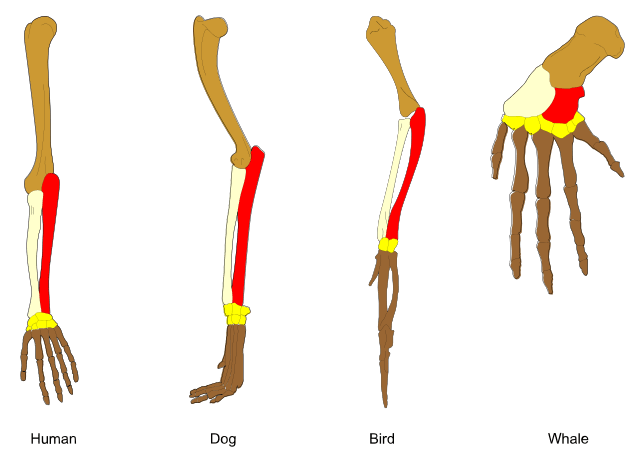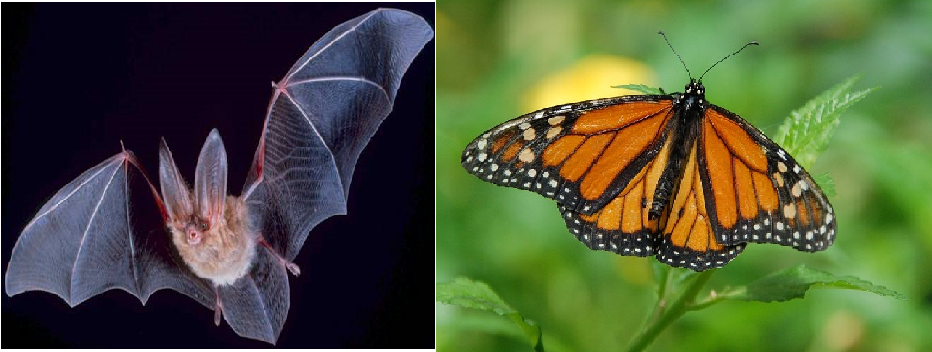Key Difference – Homologous vs Analogous Structures
Similarities between organisms and structures are believed to be inherited from a common ancestor. Biologists state that all living organisms must share a single last common ancestor. When critically analyzing and comparing their similarities, evidence can be identified about their evolutionary relationships. However, environment also has a great influence on organisms’ characteristics. Natural selection and adaptation lead organisms to survive or become extinct from the environment. Scientists compare anatomy, embryos and DNA data to determine the evolutionary history of organisms and build phylogenetic trees. However, phylogenetic trees or evolutionary trees are hypothesized constructions. Hence, scientists use homologous characters and analogous characters. Homologous characters are the similar characters observed in different organisms due to a common ancestor. These organisms have homologous structures. Analogous characters are the traits which show superficial similarity due to natural selection and convergent evolution. These organisms possess analogous structures. The key difference between homologous and analogous structures is that homologous structures are derived from a common ancestral structure while analogous structures are derived from different evolutionary ancestries.
CONTENTS
1. Overview and Key Difference
2. What are Homologous Structures
3. What are Analogous Structures
4. Side by Side Comparison – Homologous vs Analogous Structures in Tabular Form
5. Summary
What are Homologous Structures?
Homologous structures are the organs or the other structures in different animals which descend from a common ancestor. These structures are anatomically similar, but they may perform different functions. Homologous structures are developed in related organisms since they share a common ancestor. Homology is the term which describes the sharing of characteristics by species due to a common ancestry. There are three main types of homologies. They are morphological homology (show anatomical similarities), ontogenetic homology (show developmental (embryological) similarities) and molecular homology (show similarities in DNA, RNA, and protein).
A typical example for homologous structures is the skeletal components of vertebrates. The arm of a human, the wing of a bird or a bat, the leg of a dog and the flipper of a dolphin or whale are homologous structures.

Figure 01: Homologous Structures
These structures have different functions, but they are similar and share common traits, which indicate evidence of a common ancestry.
What are Analogous Structures?
Analogous structures have similar functions. They are not derived from a common ancestor and have different evolutionary ancestries. Analogous structures are a result of convergent evolution. Organisms that are not related possess similar traits due to the adaptation to a similar environment or ecological niches. Natural selection forces unrelated organisms to have the most efficient and practical structures for survival. Some examples of analogous structures include wings of birds, bats, and insects. These structures serve the same function in different species. But their development patterns and the origin are different.

Figure 02: Analogous Structures
What is the Difference Between Homologous and Analogous Structures?
Homologous vs Analogous Structures | |
| Homologous structures are the structures derived from a common ancestor which have similar morphology and anatomy and different functions. | Analogous structures are the structures derived from different evolutionary ancestries which have similar functions and dissimilar anatomy. |
| Anatomy | |
| Homologous structures are similar in anatomy. | Analogous structures are dissimilar in anatomy. |
| Function | |
| Homologous structures perform different functions. | Analogous structures perform similar functions. |
| Development | |
| Homologous structures develop in related animals. | Analogous structures develop in unrelated animals. |
| Development Patterns | |
| Homologous structures show similar development patterns. | Analogous structures show dissimilar development patterns. |
| Inheritance | |
| Homologous structures are inherited from a common ancestor. | Analogous structures are inherited from different ancestors. |
| Examples | |
| Examples of homologous structures include dolphin’s flipper, bird’s wing, cat’s leg, and the human arm. | Examples for analogous structures include wings of a butterfly and wings of a bat. |
Summary – Homologous vs Analogous Structures
Structures derived from a common ancestral structure that may or may not serve the same function in the species are called homologous structures. Structures derived from different ancestors that perform similar functions are called analogous structures. Homologous structures are seen in evolutionarily related species. Analogous structures are seen in evolutionary unrelated species. The anatomy of the homologous structures is similar while the anatomy of the analogous structures is dissimilar. This is the difference between homologous and analogous structures. Homologous structures are considered as evidence of evolution. Analogous structures are considered as a result of convergent evolution.
Download PDF Version of Homologous vs Analogous Structures
You can download PDF version of this article and use it for offline purposes as per citation notes. Please download PDF version here Difference Between Homologous and Analogous Structures.
References:
1 . Scoville, Heather. “What Are Homologous Structures?” ThoughtCo. N.p., n.d. Web. Available here. 26 July 2017.
2. “Analogy.” Encyclopædia Britannica. Encyclopædia Britannica, inc., n.d. Web. Available here. 26 July 2017.
Image Courtesy:
1. “Homology vertebrates-en” By Волков Владислав Петрович – Own work (CC BY-SA 4.0) via Commons Wikimedia
2. “Big-eared-townsend-fledermaus” By PD-USGov (Public Domain) via Commons Wikimedia
3. “171555” (Public Domain) via Pixabay
ncG1vNJzZmivp6x7pbXFn5yrnZ6YsqOx07CcnqZemLyue8OinZ%2Bdopq7pLGMm5ytr5Wau260zqampaeXpMK0ecCnm2auo2Kur63LqJ6oraNiwLW%2B1JyrrqqVqHw%3D